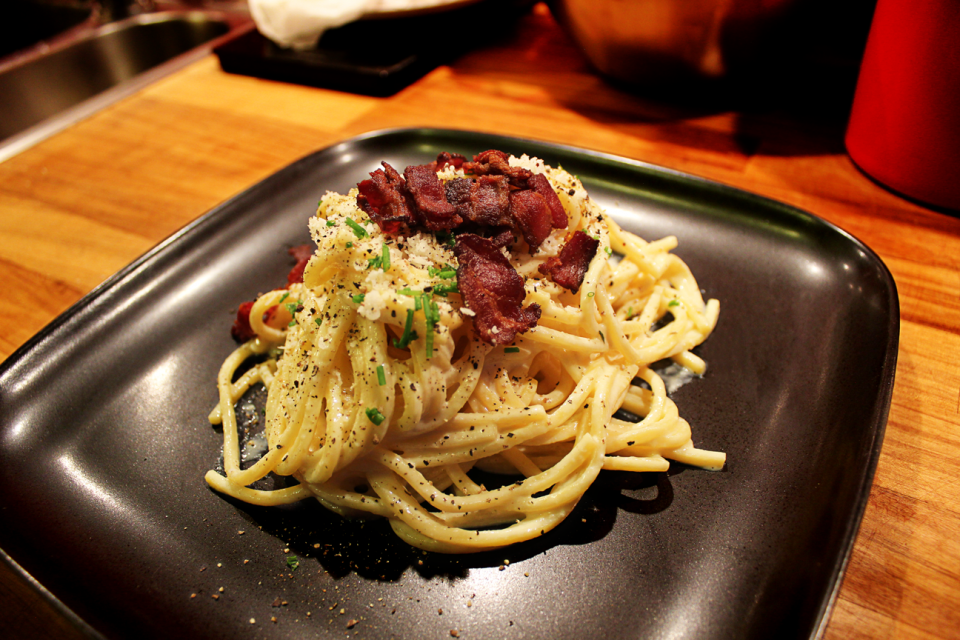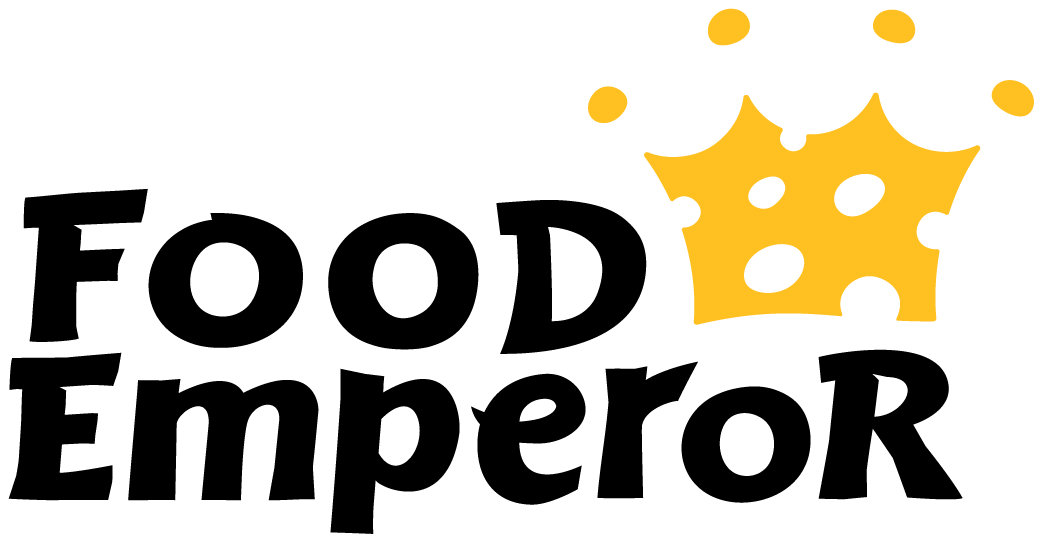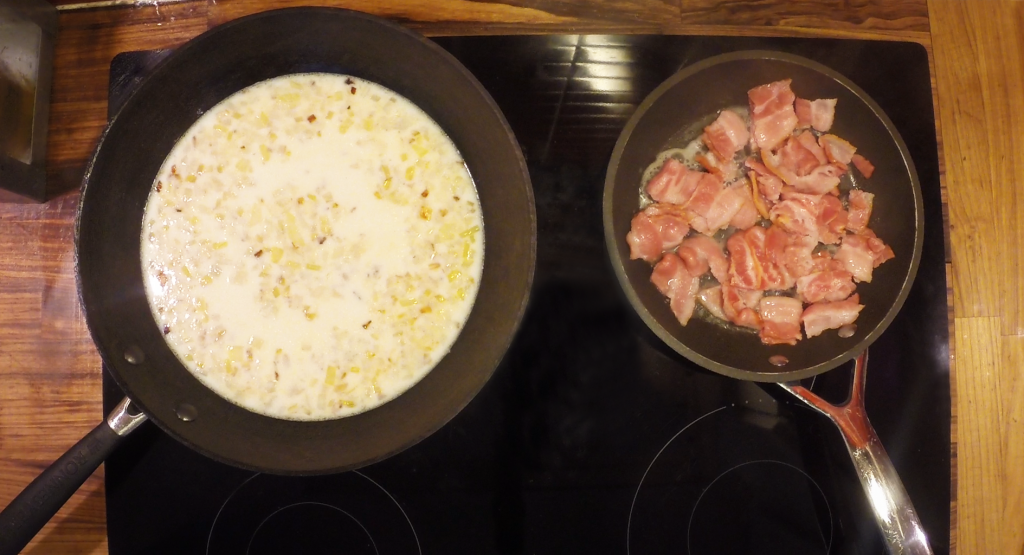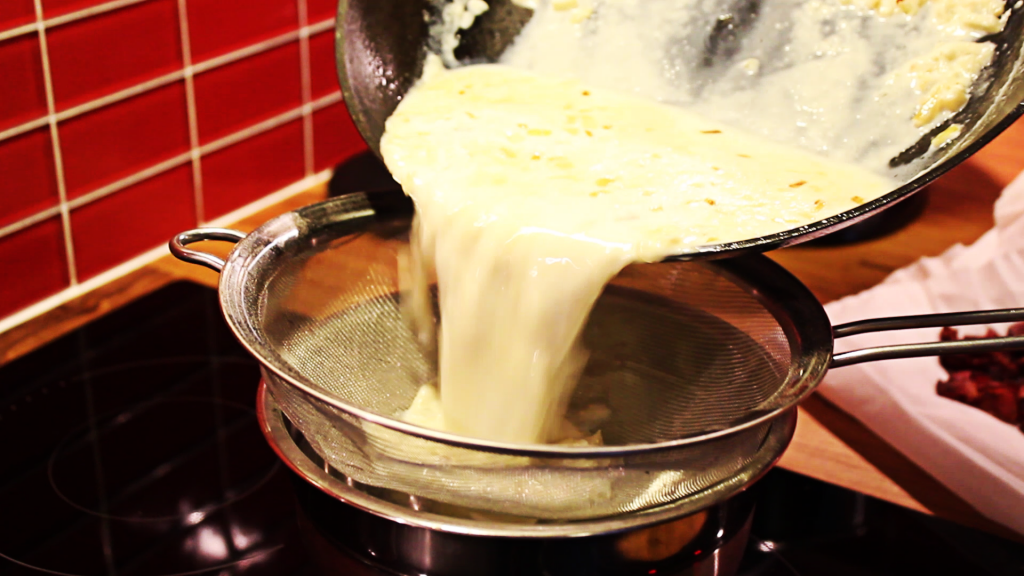A futuristic pasta alla carbonara

A classic carbonara is simply pasta mixed with fried guanciale or pancetta, together with its fat, raw eggs and pecorino cheese. The name is derived from carbonaro, which means charcoal burner. I read that the dish got its name from being popular among Italian charcoal workers. I don’t know if there’s any truth to the etymology of the name though.
The dish doesn’t have a tradition stretching back hundreds of years, it was invented in the 1950’s, so you’re not breaking any great grandparent’s hearts by improving it. I know Italians are very traditional when it comes to food. One of the world’s best chefs, Massimo Bottura, said in an interview that locals didn’t appreciate his modern interpretation of Italian dishes. It wasn’t until he was internationally acclaimed that Italians too started to at least accept him as a master of cooking. I’m no Massimo Bottura, but I like cooking as a hobby and I like to evolve recipes. This is my take on the pasta alla carbonara.
I love of the variation of carbonara most commonly found outside of Italy. If you ask a Swede or an American what a carbonara is, they’ll likely describe it as a cream sauce. That’s interesting, considering that cream isn’t an ingredient in the recipe being served in its country of origin. Also, I like using butter in my carbonara to get a buttery flavor. Although Italians sometimes use butter, it’s quite uncommon for this pasta dish. I also like a touch of sweetness from caramelized onions, that go really well with the salty bacon/pancetta. Wait, onions in a carbonara?! I could tell you about the aromatic compounds that develop when caramelizing onions (e.g disulfides, mercaptans, thiopenes, trisulfides), and I could tell you how well the flavor goes with the rest of the dish, but in the end, you should really try it out for yourself. I’m confident you’ll love it.
Time it takes:
- 1 minute to chop up the onion and pancetta
- 30 minutes of active and passive cooking (20 minutes of waiting for the onion infusion, followed by 10 minutes to mix in the eggs, and very slowly heat the sauce up while stirring.)
- 2 minutes to mix it all up and nicely arrange it on a plate.
Ingredients:
- 250 g of pasta
- 5 dl of milk
- 2 dl of full cream
- 125 g of smoked pancetta (you can also use bacon)
- Half an onion
- 3 egg yolks
- 2 tbsp of chopped chives
- 1 dl of grated Parmesan cheese, plus extra cheese for the topping
- Butter
- Salt
- Black pepper
Instructions for the “carbonara” sauce:
- First of all, finely chop half an onion, and fry it in a pan, with some butter, until it smells delicious and gets some color.
- While the onions are developing all the wonderful aromatic compounds, chop the pancetta and place it into a cold pan. Slowly heat the pan up. The pancetta will fry in its own fat, it’s wonderful. If you don’t have pancetta, bacon will actually do just as fine.*
- When the onions are soft and smell delicious, cover them with the milk and cream. Let it simmer for about 20 minutes. The onions will infuse in the fat liquid.
- Put the crispy pancetta on some paper and let it drain. We won’t incorporate the pork fat into the pasta, as the traditional recipe calls for.
- After 20 minutes, strain the sauce through a fine sieve. Get all that good sauce out of the onions, and pour the liquid back into the pan.
- Carefully separate the egg yolks from the whites, and incorporate the yolks into the sauce on low heat. Keep stirring and keep the heat just bellow 70°C.** If the heat is to low, the sauce won’t thicken. If it’s too high, you’ll end up with a nasty grainy texture. And if you put the egg whites in there too, you’ll be eating a bad omelette.
- Once the sauce has thickened, turn the heat down on the sauce, and prepare for the pasta-boiling. A lot of water, a lot of salt, and a dash of olive oil.***
- Pass the pasta under cold water.****
- Fold the pasta into the sauce. Add grated parmesan cheese. Be careful with adding salt to the sauce. There is already some salt in the pasta, parmesan is salty and pancetta is cured with salt.
- Finally, transfer pasta on a plate, sprinkle with some parmesan, spread chives on top of it (it tastes good, and it visually prepares your guests for the sweet flavorsome onions in the sauce), add freshly ground black pepper, and you’re done!
Notes
* It’s traditionally said that the difference between bacon and pancetta is that one is cured and smoked while the other is just cured, but that’s not true, since you’ll often find smoked pancetta in Italy.
** Because it’s the temperature where the yolk coagulates.
*** I use olive oil not because it keeps the pasta from sticking (if you have a lot of water and boil furiously, it doesn’t stick anyway) but because the oil prevents white foam from rising up and over the edge.
**** Normally, I would never ask you to pass the pasta under cold water, the starch filled water should be part of a good pasta sauce. But in this case, we don’t want the water nor do we want hot pasta. You see, the heat will screw up the sauce. Indeed, if you put steaming hot pasta into the carbonara, the sauce will reach the point where the yolks coagulate and we definitely do not want that.



